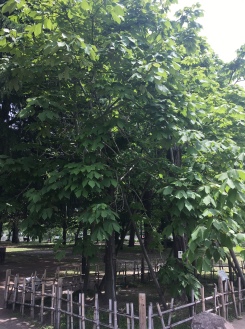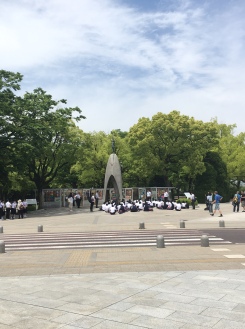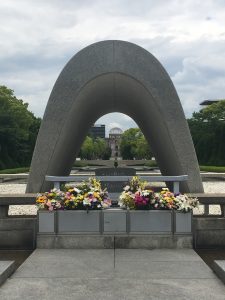Hiroshima Peace Park
June 1st, 2017
As a part of the programs provided through the World Friendship Center, the guests are taken to the Peace Park and take a tour with one of the staff members. Thus far my partner Josie and I have attended two of these tours with two different staff members. Each staff member has their own highlights as there are 122,000 square meters of the park to be covered in about an hour to an hour and a half. Starting in the eastern half of the Peace Memorial Museum, the first stop is a small gathering of trees just outside of the building. Looking at these trees, it would be hard to guess there is anything particularly special about them. These trees are in fact one of my favorite memorial sites. These Aogiri trees are a Chinese species and were originally planted about 1.3 kilometers from the hypocenter of the bomb. As they were burned to their core, these trees were considered useless, especially as the Manhattan Project predicted that nothing would grow in Hiroshima for the next seventy years. However, they were wrong. The following spring these trees miraculously bloomed once again. The strength and perseverance of these trees who had beat the odds inspired survivors to have the strength to carry on.
The A-Bomb Dome is one of the most popular memorial sites to visit. At the time of the bomb the building was used for municipal government offices. Only one individual managed to survive by the chance he was in the basement to search for a book. As a majority of the building was destroyed, a skeleton of the building still stands. In the 1990’s there was much debate as to whether the structure should be destroyed as it likely contains residual radiation and a sad memory for those who had die. On the other hand, there was a strongly united group of individuals who argued that the A-Bomb Dome was an important testament to the history of Hiroshima. The latter group had won. In 1996, UNESCO labeled the A-Bomb Dome as a world heritage site. With some preservation work done, the A-Bomb Dome continues to stand today, off-limits to venturing inside with a short, dark gate enclosing it.
Another of my favorite memorial sites is dedicated to the children who had died as a result of the bomb. Atop of the dome-like structure stands a figure representing Sasaki Sadako. Sadako was two years old at the time of the bomb and despite being flung across her kitchen, she had no major immediate injuries. Yet ten years later she had developed leukemia. Leukemia was one of the most common sicknesses resulting from the a-bomb, the most common victim being children. Sadako wanted to live more than anything. Therefore in accordance to an old superstition, she began to fold a thousand paper cranes. She exceeded her goal and had reached nearly 1,300 paper cranes when she passed away. The memorial is dedicated to her and the other children who had met a similar tragic fate. A colorful half circle of glass cases line the back of the statue. From a distance, it’s hard to distinguish what exactly are in the colorful cases. Yet up close, millions of paper cranes are packed within these cases. Paper cranes on long strings from all over the world are displayed behind the statue. Everyday an official stands to help add new paper cranes. Some of the strings of cranes are aligned to form pictures. Before I leave Japan, I would really like to learn how to fold a paper crane and perhaps add one to the collection.
As well as many Japanese who had died, many Koreans had died in Hiroshima at the time of the bomb as well. Many Koreans were forced to live in Japan after being forced to serve in the war on the behalf of the Japanese. After the war, many Koreans were disturbed by the fact that there wasn’t a memorial for the ancestors who they had lost. In 1970 the Korean memorial was constructed and in 1999 it was transported to its location now in the Peace Park. The turtle is representative of the mythology that dead souls ride on the back of a turtle upon ascending to heaven. Colorful streams of paper cranes lay across the back of the turtle’s neck in honor of the approximate 20,000 Korean lives that were lost.
Finally, as I am no photographer whatsover, I am pretty proud of this last photo. Working the way from back to front, you can see the A-Bomb Dome in the very back. Followed by the dome, it’s a little difficult but you can see the Eternal Flame of Peace. This flame carries the promise to burn until the final abolition of all nuclear weapons. In front of the flame is the Peace Pond. This pond represents those who had died begging for water. Finally beneath the arch-like structure is the cenotaph containing all the names of those who had died and the hibakusha who had eventually passed away. Once a year the journals containing these names are taken out and more names can be added. Some of the hibakusha survived to an elderly age until the passed and other names may be from family members whom finally come to terms with the loss of a loved one. The arch like structure represents a former architectural structure of Japanese styled homes and serves today to protect the names from the natural elements. Many flowers and incense are dedicated here and honor the inscription that “let all the souls here rest in peace, for we shall not repeat the evil”.
Alright… I’ll end this post with a confession…Josie and I have yet to tour the inside of the Peace Memorial Museum within the three weeks we have been here. I promise I will visit the museum, we honestly have just been so busy. We are setting aside time this Saturday to make a visit the museum and to track down the Mr. Mito we have been hearing so much about. Apparently, Mr. Mito had formally worked as a representative at the museum yet disagreed with many of the facts that the museum shared. Therefore, he broke off from the museum and as a sort of black sheep, he stands outside the A-bomb dome everyday (with a break for lunch of course) and shares his facts with anybody willing to listen. Josie and I will be all ears!
Starting from the top left: Aogiri survivor trees; close up of the Children’s Peace Memorial; distant view of the Children’s Peace Memorial; one of our awesome tour guides Miho-san; the cenotaph containing the names of the victims; the Korean memorial.






Leave a Reply